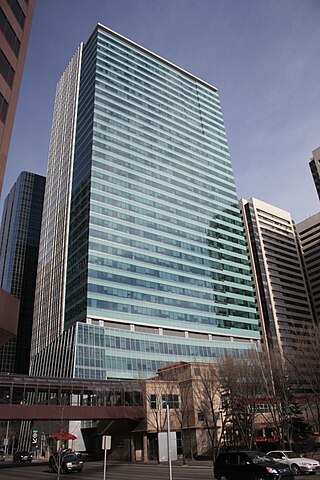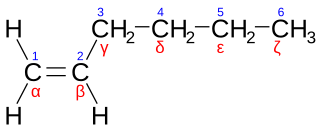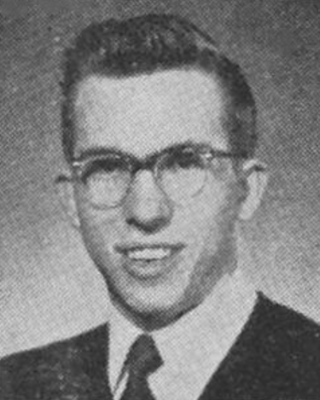
Petrochemicals are the chemical products obtained from petroleum by refining. Some chemical compounds made from petroleum are also obtained from other fossil fuels, such as coal or natural gas, or renewable sources such as maize, palm fruit or sugar cane.

The Dow Chemical Company is an American multinational corporation headquartered in Midland, Michigan, United States. The company was among the three largest chemical producers in the world in 2021. It is the operating subsidiary of Dow Inc., a publicly traded holding company incorporated under Delaware law.

Husky Energy Inc. was a Canadian company engaged in hydrocarbon exploration, headquartered in Calgary, Alberta, Canada. It operates in Western and Atlantic Canada, the United States and the Asia Pacific region, with upstream and downstream business segments. In the 2020 Forbes Global 2000, Husky Energy was ranked as the 1443rd-largest public company in the world.

TC Energy Corporation is a major North American energy company, based in the TC Energy Tower building in Calgary, Alberta, Canada, that develops and operates energy infrastructure in Canada, the United States, and Mexico. The company operates three core businesses: Natural Gas Pipelines, Liquids Pipelines and Energy.

Saudi Basic Industries Corporation, known as SABIC, is a Saudi chemical manufacturing company. 70% of SABIC's shares are owned by Saudi Aramco. It is active in petrochemicals, chemicals, industrial polymers, fertilizers, and metals. It is the second largest public company in the Middle East and Saudi Arabia as listed in Tadawul.
A polyolefin is a type of polymer with the general formula (CH2CHR)n where R is an alkyl group. They are usually derived from a small set of simple olefins (alkenes). Dominant in a commercial sense are polyethylene and polypropylene. More specialized polyolefins include polyisobutylene and polymethylpentene. They are all colorless or white oils or solids. Many copolymers are known, such as polybutene, which derives from a mixture of different butene isomers. The name of each polyolefin indicates the olefin from which it is prepared; for example, polyethylene is derived from ethylene, and polymethylpentene is derived from 4-methyl-1-pentene. Polyolefins are not olefins themselves because the double bond of each olefin monomer is opened in order to form the polymer. Monomers having more than one double bond such as butadiene and isoprene yield polymers that contain double bonds (polybutadiene and polyisoprene) and are usually not considered polyolefins. Polyolefins are the foundations of many chemical industries.

Straight-chain terminal alkenes, also called linear alpha olefins (LAO) or normal alpha olefins (NAO), are alkenes (olefins) having a chemical formula CnH2n, distinguished from other alkenes with a similar molecular formula by being terminal alkenes, in which the double bond occurs at the alpha position, and by having a linear (unbranched) hydrocarbon chain.

Showa Denko K. K., founded in 1939 by the merger of Nihon Electrical Industries and Showa Fertilizers, both established by a Japanese entrepreneur Nobuteru Mori, is a Japanese chemical company producing chemical products and industrial materials.

Richard Francis "Dick" Haskayne is a Canadian retired accountant and oilman whose career spanned from 1956 to 2005. Haskayne served as senior official of several major Canadian petroleum companies including Hudson's Bay Oil and Gas Company, Home Oil Company, Interprovincial Pipeline Company, Nova Corporation, and TransCanada Pipelines. He is also known for his association with the University of Calgary, whose management faculty was renamed the Haskayne School of Business in 2002.

1-Butene (IUPAC name: But-1-ene, also known as 1-butylene) is the organic compound with the formula CH3CH2CH=CH2. It is a colorless gas. But-1-ene is an alkene easily condensed to give a colorless liquid. It is classified as a linear alpha-olefin (terminal alkene). It is one of the isomers of butene (butylene). It is a precursor to diverse products.

Petroleum production in Canada is a major industry which is important to the overall economy of North America. Canada has the third largest oil reserves in the world and is the world's fourth largest oil producer and fourth largest oil exporter. In 2019 it produced an average of 750,000 cubic metres per day (4.7 Mbbl/d) of crude oil and equivalent. Of that amount, 64% was upgraded from unconventional oil sands, and the remainder light crude oil, heavy crude oil and natural-gas condensate. Most of the Canadian petroleum production is exported, approximately 600,000 cubic metres per day (3.8 Mbbl/d) in 2019, with 98% of the exports going to the United States. Canada is by far the largest single source of oil imports to the United States, providing 43% of US crude oil imports in 2015.

The National Petrochemical Company (NPC), a subsidiary to the Iranian Petroleum Ministry, is owned by the government of the Islamic Republic of Iran. It is responsible for the development and operation of the country's petrochemical sector. Founded in 1964, NPC began its activities by operating a small fertilizer plant in Shiraz.

Canada's natural gas liquids industry dates back to the discovery of wet natural gas at Turner Valley, Alberta in 1914. The gas was less important than the natural gasoline - "skunk gas" it was called, because of its distinctive odour - that early producers extracted from it. That natural gas liquid (NGL) could be poured directly into an automobile's fuel tank.
Borealis AG is an Austrian plastics manufacturer. As the second largest producer of polyolefins in Europe, it is one of the market leaders in the petrochemicals industry.
SIBUR is a Russian petrochemicals company founded in 1995 and headquartered in Moscow.
Pembina Pipeline is a Canadian corporation that operates transportation and storage infrastructure delivering oil and natural gas to and from parts of Western Canada. Western Canada is the source of all products transported by Pembina pipeline systems.
Lotte Chemical Titan Holding Sdn Bhd engages in the ownership and operation of polypropylene plants, polyethylene plants, ethylene crackers, and aromatic plants. It offers high-density polyethylene (HDPE), Low-density polyethylene (LDPE), and Linear low-density polyethylene (LLDPE) for various kinds of applications, room household goods to automotives products. The company also manufactures low-density polyethylene for injection molding for cosmetic containers, bottle closures, and food containers, and is based in Pasir Gudang, Malaysia.
Westlake Corporation is an international manufacturer and supplier of petrochemicals, polymers and fabricated building products, which are fundamental to various consumer and industrial markets. The company was founded by Ting Tsung Chao in 1986. it is the largest producer of low-density polyethylene (LDPE) in the US and ranks among the Forbes Global 2000. Westlake Chemical operates in two segments: Olefins and Vinyls, and is also an integrated producer of vinyls, with substantial downstream integration into polyvinyl chloride (PVC) building products.
Cedar Bayou plant is a petrochemical manufacturing facility located in Baytown, Texas. It is the largest U.S. manufacturing facility of Chevron Phillips Chemical Company. The plant operates seven process units on approximately 1,400 acres producing Ethylene, Propylene, Normal Alpha Olefins (NAO), High Density Polyethylene (HDPE), Low Density Polyethylene (LDPE), Linear Low Density Polyethylene (LLDPE), and Polyalphaolefins. Cedar Bayou plant opened in 1963 as Gulf Oil and was sold to Chevron Corp. in 1985. In 2000, Chevron Corp. and Phillips 66 merged their chemical businesses to form Chevron Phillips Chemical Company.
Formosa Petrochemical Corporation is a Taiwanese energy company engaged in refining of crude oil, distribution of refined petroleum products, the production and sales of olefins, and the generation of electricity and steam. It was founded as a subsidiary of Formosa Plastics Group, and went public in 2003. It is headquartered in Mailiao Township, Yunlin County, in Taiwan.









